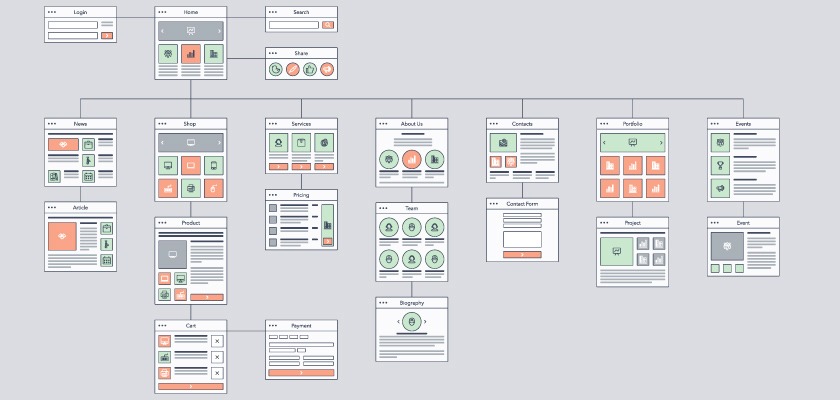Internal linking, or the creation of links between different pages of your website, is a simple tactic included with most SEO services. Internal linking strategies are easy to implement and crucial for your SEO success.
Adding internal links will allow you to create a website hierarchy, drive traffic through your entire website and encourage visitors to spend more time on your site.
Internal linking is also an important tool for search engines. Search engines such as Google and Bing crawl websites using internal links. Using internal links and anchor text strategically will allow search engines to understand your content more effectively.
There are several different types of internal links you can use:
- Navigation links: The most common type of internal links, these links create a structure for your website and guide the reader through the content. Navigation links are included on every page of your site.
- Editorial links: Editorial links are the links that are included within the body copy of your website. These links can be woven into your site content organically, and are the most valuable links for your site.
- Taxonomy and categorical links: These links join common topics, such as related posts or blog categories, together to make content easier for users to find. They also can link to parent service pages.
- Footer or site-wide links: Located at the bottom of your page, footer links are used to optimize the usability of your website. The footer of a site typically includes contact information, social media widgets, an internal search tool for your site.
Why Is Interior Linking Important?
Using internal linking has four key benefits:
Establishing a Hierarchy
Interior linking establishes relationships and creates a clear hierarchy between content pages on your site so you can direct users and search engines to your most important content. The links you choose to include on the homepage will be higher up in the hierarchy and more authoritative.
Develops Link Equity
Internal linking can help your pages build link equity. When you link pages from your most authoritative pages, the linked pages are seen to have more value and authority because of their relationship to the more important page. This link equity enables your more trafficked pages to share some of their authority to new pages or pages that you would like more users to see.
Increases Crawlability
Internal linking helps with Google crawlability, which will ultimately drive traffic to your site. Website crawling is the process where software automatically “crawls” through your pages to index the content of your website. Adding links makes it easier for search engines to discover all the pages on your site, which means that your website will show up more often in search results.
Improved User Experience
Setting up a clear internal linking system helps users navigate your site. Internal links make it easier for users to find what they are looking for, and can help them discover new content that interests them by making it easily accessible and convenient for them to stumble upon while browsing.
Creating Your Best Internal Linking Strategy
Internal linking is most effective when developing a well thought out plan before you start adding links. The following tips will help you design a winning strategy to organize your links.
Build a Link Tree
Design a link tree to map out all the different pages on your website and how they relate to one another. This will ensure each page fits within your intended site hierarchy.

Crawl Your Website
Use a tool like SEO Screaming Frog to crawl your website. This crawl will essentially serve as an audit of your site and will populate a list of your current pages and how many interior links each of them has already. This tool will give you an idea of how many links you need to create to make pages “important” and rank higher on search engine crawls.
PRO TIP: A web crawl audit will also show you how to diagnose crawl errors such as 301s and 404s.
Have a Clear Navigation
Use user-friendly links that are easy-to-find and uncluttered to link your homepage to your top pages. When you make your navigation clearer, it is easier for users to find the pages that you want them to see.
Link Relative Content Together
Linking relative content in groups allows search engines to contextualize what your page and the subject matter of your site content. For example, if you have a page on your website that discusses air conditioning repair, you will want to create internal links to and from your page common air conditioning issues, how to know when to call your air conditioning repairman and other similar air-conditioning related content.
Pass Link Equity to Important or New Content
You want to pass link equity from your highly authoritative pages that receive lots of backlinks to pages that need that link equity. Discover which of your pages are the most authoritative by using a tool like ahrefs, or majestic to identify your pages that receive lots of backlinks. Then create links from those pages to relevant content pages that need more authority or are your focus pages.
Use Appropriate and Keyword Rich Anchor Text
Anchor text is the clickable hyperlink text in your copy, usually blue and underlined, that links to other pages. Anchor text helps both your users and search engines like Google understand what type of content they can expect if they click the link. Be selective about your anchor text. Choose keyword-rich phrases that concisely describe the linked page. Also, be sure not to use the same anchor text for multiple pages—this can confuse crawl bots.
Don’t Go Overboard
Putting too many internal links not only can make your website look cluttered and unprofessional, but it also can over-optimize your site. Over-optimization occurs when Google finds an excessive amount of SEO-optimizing tactics on a single site, assumes the site is spam and pushes the site down in search result rankings. Also, keep in mind that Google only recognizes the first link and anchor when it crawls on a page.
Internal Linking Is an Ongoing Strategy – Check on Links Regularly
Strategically adding internal links to your website is an essential practice to improve SEO and user experience with minimal effort.
As you build more content and your site continues to grow in size, make sure to crawl your site and check on your internal links on a regular basis to keep your page up to date and take advantage of all the benefits internal linking has to offer.


